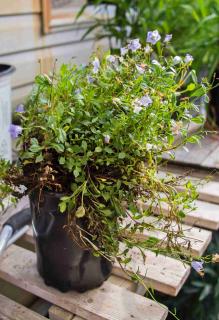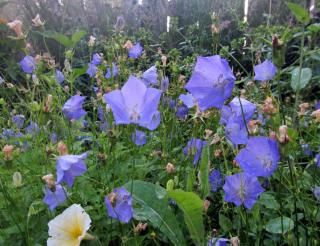

The Carpathian bellflower is different from its cousins in that its magnificent blue-violet blooms are a lighter color.
Carpathian bellflower key facts :
Botanical name – Campanula carpatica
Family – Campanulaceae
Type – perennial
Bearing – low-lying ground cover
Height – 8 inches (20 cm)
Planting density – 6 to 8 plants per sq. yard (m²)
Exposure – full sun to part sun
Soil – any type, well drained
Flowering: June to September
Its leaves are teeny tiny, and shaped like hearts. Their light green color is simply perfect to decorate your outdoors when other blooms aren’t as prominent. This abundant flower-bearer that isn’t too invasive is the perfect add-on to every summer garden.

Apart form this precaution, no other soil preparation is necessary to plant it. Simply dig a 4 to 6 inch hole (10 to 15 cm) and settle your plant in it before backfilling.
Since Carpathian bellflower is a variety that doesn’t send any runners out, make sure you don’t space your plants out too far apart, especially if you’re aiming for a lush, homogenous ground cover. If this is your goal, space plants at most 12 to 16 inches (30 to 40 cm) apart.

Pruning won’t be necessary. Nonetheless, wilted flowers sometimes seem to spoil the show, so you can remove them by pulling them off gently with your fingers. The plant will then generate a new round of foliage.
Carpathian bellflower may be targeted by snails and slugs who love attacking young leaves. To a lesser extent, you might discover frothy spittlebug, or froghopper larvae. These might weaken the plant if present in great numbers.
Diseases that most often infect bellflower include powdery mildew and rust.
Clump division is the easiest and fasted method to propagate Carpathian bellflower. To do so, simply pull the perennial out of the ground without damaging the clump too much. Then, break the clump up in as many smaller clumps as you need to get the right number of new plants. Replant them immediately where you think best.
To increase your chances of success, wait for fall in order to start dividing your plants.
As is the case for a great many bellflower species, Carpathian bellflower is a ground cover perennial that’s ideal to fill in rocky terrain, flower holes in stone walls, mark edges and even simply garden boxes. You also have the option of growing it in flower beds, but you’ll have to plant it in front.
Carpathian bellflower also exists with white blooming. These are the ‘Alba’ and ‘Weisse Clips’ cultivars (also called ‘White Clips’).